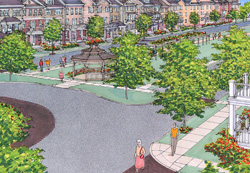Building in Flexibility – Development Framework Planning
July 13th, 2010
In today’s project entitlement environment, municipalities are requiring increasing levels of design detail from applicants prior to granting preliminary site plan approvals. Often developers are forced to provide full schematic or even design development level engineering and architectural drawings for each proposed building within a development. This is both costly and risky, as it limits the flexibility needed to address market and demographic shifts over time. Add to that the volatility in both the debt and equity markets, and developers can be saddled with an enormous upfront expenditure, as well as financial commitments, on project entitlements that may ultimately lose their value.
One solution is to engage in a design-oriented entitlement process that is more in concert with a master planning exercise, and concentrates on an overall development framework.
In a framework plan, detailed designs are proposed for the public realm – the streets, parks and open spaces within a parcel. Design standards and guidelines are then provided for the actual buildings that while more specific than those outlined in conventional zoning ordinances, are less constraining than fully engineered drawings, thereby building in much needed flexibility. This process provides the regulating bodies with a comfort level that the improvements to the public realm – the placing making elements – will come to fruition as the project is realized.
Building footprints and even the end uses can then change as necessary to respond to the market without changing the approved and established character of the development.
Key to this approach is a concentrated and iterative urban design process with regulating bodies, private developers, and designers working together to achieve entitlements. BartonPartners has developed a set of design oriented tasks, presented as a menu of services that are tailored to each individual project, to address this process. The upfront, pre-entitlement expenditure on this effort, while not insubstantial, is far less expensive than the alternative – months or years of back and forth discussions, multiple re-designs and consultants, and in the end, projects that cannot respond to changing market conditions and are therefore vulnerable to failure. In short, a master planning process which utilizes a development framework approach can go a long way to insuring the ultimate success of your project.

